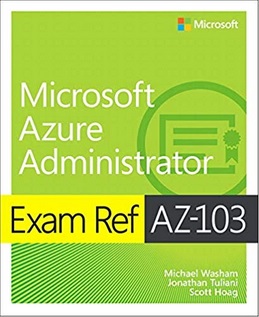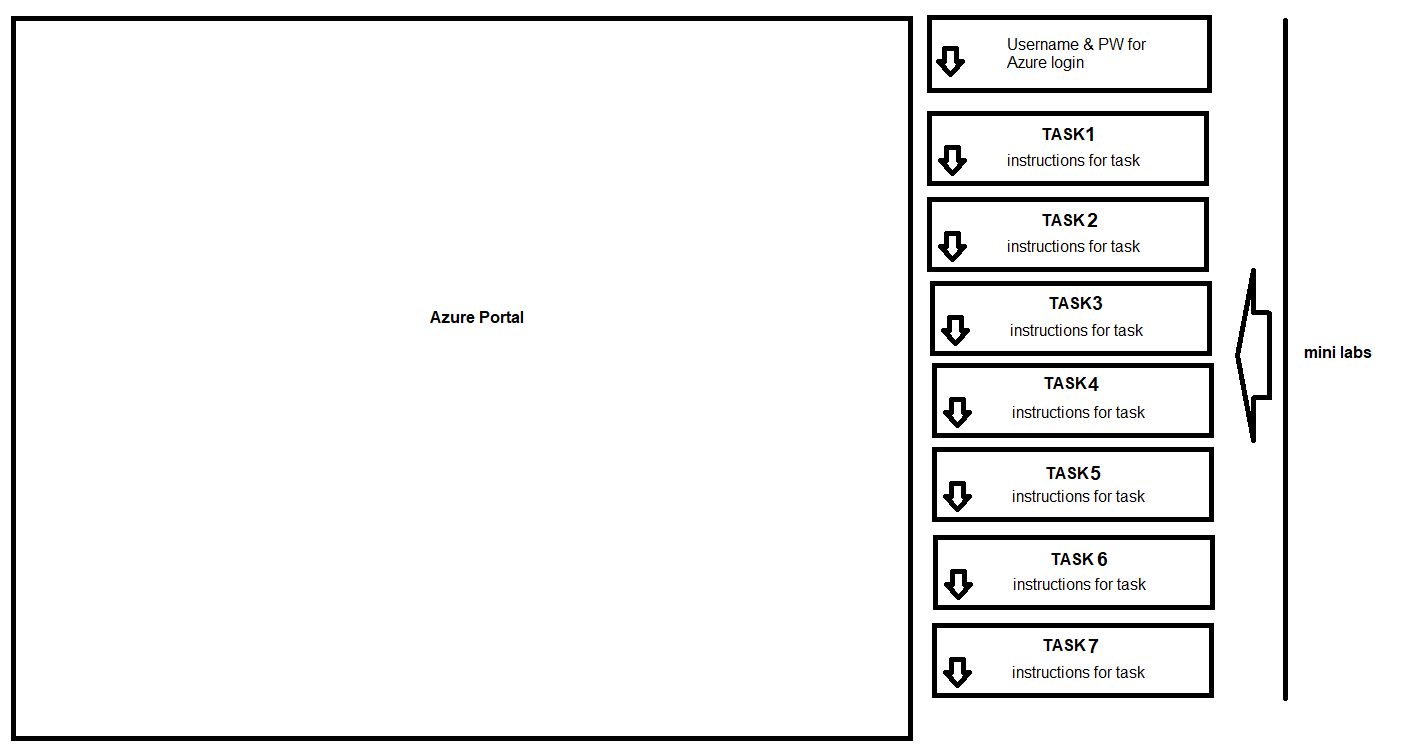Recommended Book

also located here: Oreilly.com
About
Exam AZ-103 focuses on skills and knowledge needed to manage Azure subscriptions; analyze resource utilization and consumption; manage resource groups; establish storage accounts; import/export data; configure Azure files; implement backup; create, configure, and automate VM deployment; manage VMs and VM backups; implement, manage, and connect virtual networks; configure name resolution; create and configure Network Security Groups; manage Azure AD and its objects; and implement and manage hybrid identities.
A NEW VERSION OF THIS EXAM, AZ-104, WILL BE AVAILABLE IN LATE MAY/JUNE APRIL. You will still be able to take this exam for ~90 days after the release of AZ-104. Specific dates related to the availability of AZ-104 and the retirement of AZ-103 will be posted to the website when they are known. Please download the skills measured document below to see what will be changing.
AZ-104 is available…check it out here: https://docs.microsoft.com/en-us/learn/certifications/exams/az-104
AZ-104 page I created is here: https://eddiejackson.net/lab/exam-az-104-microsoft-azure-administrator/
Cost
$165.00
* It’s free at any Ignite event (register early)
My Certification
Resources
Microsoft Learn – Azure [free] [sign-in to use]
{ Online }
● LABS and LEARNING: Administer infrastructure resources in Azure
● LABS and LEARNING: Manage resources in Azure
● LABS and LEARNING: Architect network infrastructure in Azure
● LABS and LEARNING: Deploy a website with Azure virtual machines
● LABS and LEARNING: Architect a data platform in Azure
● LAB: Create Azure users and groups in Azure Active Directory
● LAB: Create a Windows virtual machine in Azure
● LAB: Add and size disks in Azure virtual machines
● LEARNING: Core Cloud Services – Azure data storage options
● LAB: Create an Azure Storage account
● LAB: Store application data with Azure Blob storage
● LAB: Connect your on-premises network to Azure with VPN Gateway
Assessment Spreadsheet [free] [use this]
AZ-103 BRK3201 Slide Deck (Microsoft) (pptx) [free]
AZ-103 BRK3201 Exam Coverage at Ignite (Microsoft) (video) [free]
Microsoft Azure Administrator (AZ-103) | 17h (Pluralsight) [paid]
Microsoft AZ-103 Azure Administrator Exam Certification | 7h 33m (SkyLines) [paid] [requires login]
PowerShell Reference Guide AZ Module (SkyLines) (PDF) [free]
AZ-103 Course by Jiang Robin | 9h (YouTube) [free]
Azure AZ-103 Exam Prep by CloudAndYou | 10h (YouTube) [free] [excellent]
Azure 20-533 Exam Prep training series | 6 videos (CloudAndYou) (YouTube) [free]
Study Guide for the AZ-103 Course (Skylines) [free]
Automate Azure tasks using scripts with PowerShell [free]
Azure Lab Modules (Microsoft) (training) [free] [review these]
Exam Quiz
001: How do you install the Az Module?
Install-Module Az -AllowClobber
Reference:
https://docs.microsoft.com/en-us/powershell/azure/new-azureps-module-az?view=azps-2.5.0
002: What is the cmdlet to log into Azure?
Connect-AzAccount, or alias Login-AzAccount
Reference:
https://docs.microsoft.com/en-us/powershell/module/az.accounts/connect-azaccount?view=azps-2.5.0
Exam Notes
Install Azure Mobile App to monitor Azure
– Stay connected to the cloud
– Check status and critical metrics anytime
– Diagnose and fix issues quickly
– Run commands to manage your Azure resources
Check for Azure PowerShell Modules
– C:\Program Files\WindowsPowerShell\Modules
– Look for Az names
– If not there, run Install-Module Az -AllowClobber
Subscription
– There will be cost associated with a subscription
– A logical boundary in which you deploy resources
– PowerShell: Get-AzSubscription
Exam Labs
You need to know how to use the Portal to complete numerous tasks. Without covering any questions, the sims are very realistic…and appear to be an actual Azure environment. In my exam, there were 2 full labs, with a total of 13 tasks I had to complete. I would consider each task a mini-lab. It’s not easy, if you don’t have experience using the Portal. Make sure you practice applying the objectives.
Microsoft has hands-on labs you can use for practice. I recommend leveraging those valuable resources.

Exam Objectives
Exam Objectives: Objectives (Microsoft) Objectives (Eddie)
Manage Azure subscriptions and resources (15-20%)
Manage Azure subscriptions +
Notes
Make the most of Azure by optimizing your cloud spend through Azure Cost Management
more to be added
Assign administrator permissions [media]
Configure cost center quotas and tagging 2 [media]
Configure Azure subscription policies at Azure subscription level [media]
Analyze resource utilization and consumption [media] [media] [media]
Notes
to be added
Configure diagnostic settings on resources
Create a baseline for resources
Create and test alerts [media]
Analyze alerts across subscription
Analyze metrics across subscription
Utilize Log Search query functions
Manage resource groups [media]
Notes
to be added
Use Azure policies for resource groups [media]
Configure resource locks [media]
Configure resource policies [media]
Identify auditing requirements
Implement and set tagging on resource groups [media] [media]
Move resources across resource groups [PowerShell]
Remove resource groups [media]
Managed role-based access control (RBAC) + [train] [media]
Notes
to be added
Configure access to Azure resources by assigning roles
Configure management access to Azure
Implement and manage storage (15-20%)
Create and configure storage accounts + [train] [media] [media]
Notes
to be added
Configure network access to the storage account
Create the storage account [PowerShell]
Generate shared access signature [media]
Install and use Azure Storage Explorer [media]
Monitor activity log by using Log Analytics [media]
Implement Azure storage replication [media]
Import and export data to Azure [media]
Notes
to be added
Configure and use Azure blob storage [media]
Configure Azure content delivery network (CDN) endpoints [media]
Configure Azure files [media] [media]
Notes
to be added
Create Azure File Sync service
Implement Azure backup
Notes
to be added
Configure and review backup reports
Create Recovery Services Vault
Create and configure a backup policy
Deploy and manage virtual machines (VMs) (15-20%)
Notes
az vm restart -g MyResourceGroup -n MyVm
Create and configure a VM for Windows and Linux [train] [media]
Configure high availability [media]
Configure monitoring, networking, storage, and virtual machine size
deploy and configure scale sets:
Automate deployment of VMs [media]
Notes
to be added
Modify Azure Resource Manager template [media]
Configure the location of new VMs
Configure VHD template [media]
Save a deployment as an Azure Resource Manager template [media]
Manage Azure VM
Notes
to be added
Automate configuration management by using PowerShell Desired State Configuration (DSC) and VM Agent by using custom script extensions 2
Move VMs from one resource group to another
Manage VM backups
Notes
to be added
Azure Site Recovery [media] [media]
Configure and manage virtual networks (30-35%)
Create connectivity between virtual networks [train] [media]
Notes
to be added
Create and configure VNET peering [media]
Create and configure VNET to VNET
Verify virtual network connectivity
Create a virtual network gateway
Implement and manage virtual networking [media]
Notes
to be added
Configure private IP addresses
Configure name resolution
Notes
to be added
Configure custom DNS settings [media]
Configure private and public DNS zones [media]
Create and configure a Network Security Group (NSG) [media]
Notes
to be added
Associate NSG to a subnet or network interface
Evaluate effective security rules
Implement Azure load balancer
Notes
to be added
Configure the internal load balancer
Configure load balancing rules
Configure a public load balancer [media]
Monitor and troubleshoot virtual networking
Notes
to be added
Monitor on-premises connectivity
Use Network resource monitoring
Troubleshoot external networking
Troubleshoot virtual network connectivity
Integrate on-premises network with Azure virtual network
Notes
to be added
Create and configure Azure VPN Gateway [media]
Create and configure site to site VPN [media]
Configure Express Route [media] [media]
Verify on-premises connectivity
Troubleshoot on-premises connectivity with Azure
Manage identities (15-20%)
Manage Azure Active Directory (AD)
Notes
to be added
Configure self-service password reset [media]
Manage Azure AD objects (users, groups, and devices) [media] [media]
Notes
to be added
Manage user and group properties 2
Implement and manage hybrid identities
Notes
to be added
Install Azure AD Connect [media]
Implement password hash with Azure AD Connect
Implement pass-through synchronization with Azure AD Connect
Implement multi-factor authentication (MFA) [media] [media]
Notes
to be added
Configure user accounts for MFA
Enable MFA by using a bulk update
Configure verification methods
tags: AZ-103, Certification, Microsoft Exam, MrNetTek
